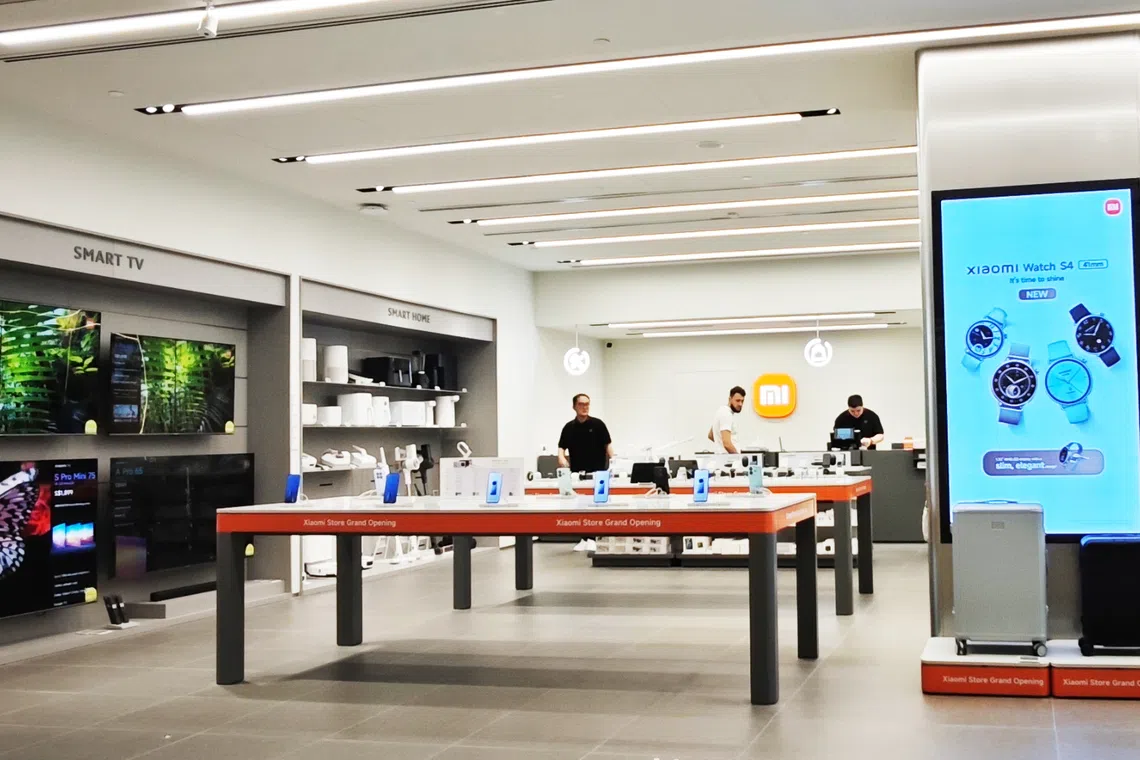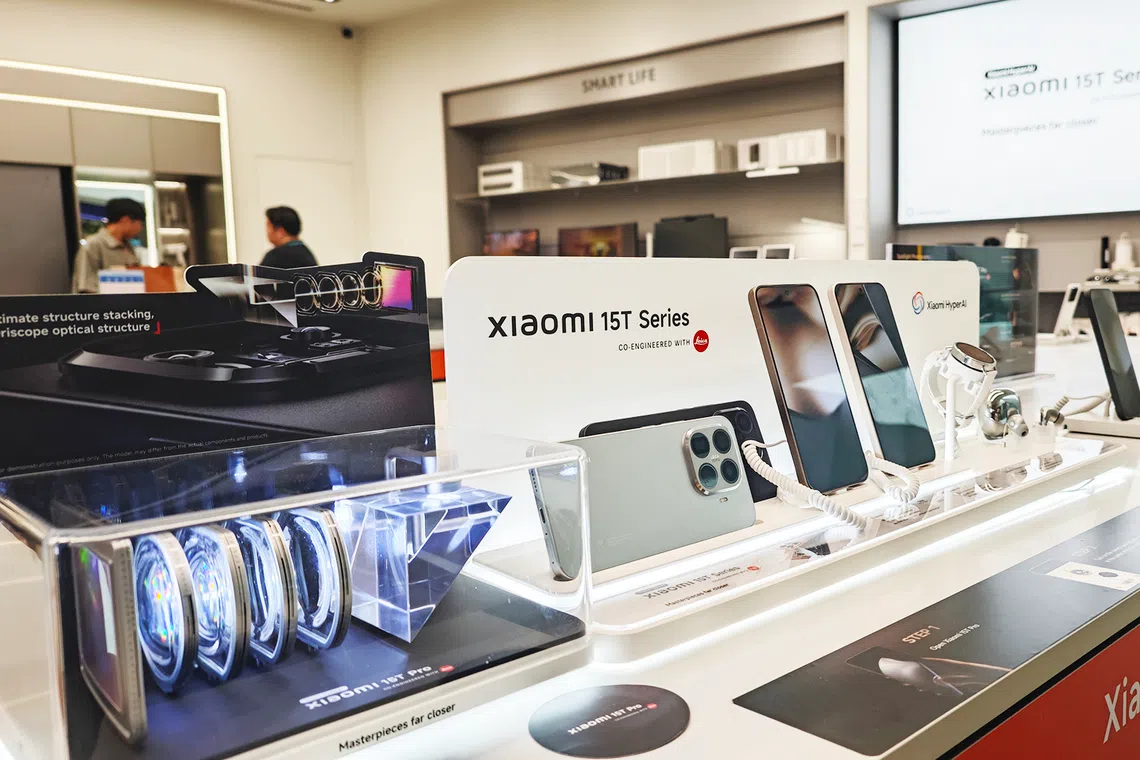Branded content
Your phone, home and car all talking to one another: Xiaomi’s AI ecosystem explained
At the Chinese tech giant’s new Jewel Changi Airport store, visitors can experience first-hand how advanced R&D and premium design power a seamless, connected lifestyle

Xiaomi’s store in Singapore at Jewel Changi Airport allows visitors to experience first-hand how smartphones, smart home devices and more work as one integrated, intelligent system.
PHOTO: XIAOMI
Follow topic:
For the first time in Singapore, visitors can get up close to the Xiaomi SU7 Ultra, the company’s flagship smart electric vehicle (EV), on display for a limited period, in celebration of Xiaomi’s newly opened Jewel Changi Airport store.
While the car is not for sale here, its appearance underscores the brand’s ambition to complete the loop on its vision of a fully integrated ecosystem, where mobile phones, appliances and vehicles interact seamlessly to deliver what it calls an intelligent lifestyle.
For Xiaomi’s vice-president and chief marketing officer Xu Fei, the brand’s Human × Car × Home strategy lies at the heart of its long-term growth.
“‘Human’ refers to personal devices like smartphones, wearables and AI assistants. ‘Car’ represents intelligent mobility, while ‘Home’ is the connected living environment. By integrating these three, we want to create a people-centred ecosystem that delivers a seamless intelligent lifestyle,” the 42-year-old executive explains.

Visitors can get up close to the Xiaomi SU7 Ultra by the Rain Vortex at Jewel Changi Airport.
PHOTO: APRW
From smartphones to EVs
The display of the SU7 Ultra in front of Jewel’s Rain Vortex encapsulates Xiaomi’s transformation, evolving from a maker of affordable personal gadgets into a premium technology brand that integrates advanced engineering with lifestyle design.
The company built its early success on mobile phones, expanded into smart home products and now extends its integrated ecosystem to include EVs, as the next chapter of its innovation story unfolds. Xiaomi’s EVs are currently available only in China, where prices start from 215,900 yuan
Underlying all three product lines of smartphones, home appliances and EVs is a core promise to make the devices work together to redefine connected living – your phone tells you when your EV is charged and the air-conditioning is on, while your car links to your home and other connected gadgets through a single ecosystem.

Xiaomi was the top-selling smartphone vendor in South-east Asia in the second quarter of this year, according to research firm Canalys.
PHOTO: XIAOMI
Since 2020, Xiaomi has been transforming itself from an internet company into what it calls a “hardcore technology company”. Between 2020 and 2025, it will have invested more than 100 billion yuan in R&D.
In 2024, the company ranked among China’s top 10 private firms for R&D spending, and this year its investment is set to exceed 30 billion yuan. Xiaomi now employs more than 22,000 engineers worldwide, focusing on developing chips, artificial intelligence (AI) and operating systems.
Central to its innovation is AI – a field Xiaomi has been investing in since 2016. This year alone, about a quarter of its total R&D spend was allotted to AI-related initiatives. One example is the integration of DeepSeek AI into its Super XiaoAI assistant and HyperOS 2 platform, the company’s unified operating system, enabling users to control devices more intuitively through voice and text commands.
Embracing a digital ecosystem
Company data shows that millions of users worldwide now own several Xiaomi devices – from smartphones and wearables to robot vacuums and smart appliances – all managed through a single app.
Its 203 sq m Xiaomi store in Jewel reflects this vision, allowing visitors to experience how these products connect seamlessly within one intelligent system. Over the next five years, the company aims to open 10,000 stores globally, according to Ms Xu.

Xiaomi is introducing its intelligent ecosystem that includes not just smartphones, but also large home appliances to South-east Asia.
PHOTO: XIAOMI
Xiaomi’s global expansion began in 2014, with Singapore serving as its first launchpad into overseas markets, including South-east Asia. The company was the top-selling smartphone vendor in the region in the second quarter, shipping 4.7 million units and capturing 19 per cent of the market, according to research firm Canalys.
In March 2025, the tech giant introduced its home appliance line to South-east Asia. To date, Xiaomi has sold over 10,000 units in the region, including more than 8,500 air conditioners, while its Mijia Front Load Washer Dryer sold out within a month in Singapore.
“In our early years abroad, Xiaomi was positioned much like in China – known for value-for-money, but also youthful, approachable and stylish. Now we are pushing into the premium market,” Ms Xu says.
That shift, however, is not simply about raising prices. “It’s about innovative technology and differentiated experiences delivered through our Human × Car × Home ecosystem,” says Mr Zeng Xuezhong, Xiaomi’s senior vice-president and president of the International Business Department.
Alongside strengthening its ecosystem, Xiaomi plans to accelerate its global presence. In September 2025, it launched its home appliance line in Europe. Next on Xiaomi’s global expansion roadmap is taking its EVs overseas.
“In 2027, Xiaomi cars will officially enter overseas markets, with Europe as the first stop. Our clear goal is to become one of the top five carmakers globally within 15 to 20 years,” Ms Xu says.


